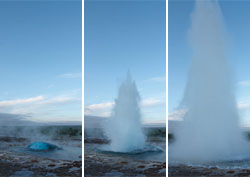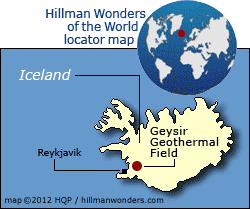Geysir Geothermal Field
 Why the Geysir
Geothermal Field is special
Why the Geysir
Geothermal Field is specialThis small area has various geothermal features including a number of geysers.
What to see
Top 2 attractions
Most of the geysers in the area are small and feeble. But two geysers – the famous Great Geysir and the more dependable Strokker Geysir – are robust. They are the ones that attract tourists.
- Great Geysir
It once erupted frequently and its expelled steam-water soared approximately 70 meters (230 feet). The last majestic eruption was in 2000. Today, the Great Geysir is fairly inactive and weak, though you might be fortunate to witness a majestic eruption. (Note: This attraction also goes simply by the name "Geysir".)
- Strokker Geysir
Although its discharge rises "only" 25 to 35 meters (80 to 110 feet), Strokker Geysir often performs on a 5 to 15 minute frequency cycle, to the joy of visitors. It sits about 50 meters (150 feet) south of the Great Geysir.
Name
Several centuries or so ago, Icelanders aptly bestowed the name “Geysir” (“gush" in ancient Norse) on what is known today as the "Great Geysir" or simply "Geysir".
Nowadays, nearly all the world's sprouting thermal features incorporate Geyser in their names. (The spelling "geyser" is the English translation.)
Earthquakes
Geologists have proven that increased geothermal activity follows earthquakes.
Some people (including scientists) have tossed soap into the Great Geysir's mouth to artificially cause eruptions. Not a good idea. Although the method works, it can seriously damage a geyser, sometimes permanently.
Grand Circle tour route
The Geysir Geothermal Field is one of the three top attractions on the popular Grand Circle tour circuit. The other two are Gullfoss waterfall and Thingvellir.
Distances
The site is 40 kilometers (25 miles) northeast of Reykjavik – and a short drive from Gullfoss waterfall.
World's other leading geothermal areas
They include Yellowstone National Park (USA), Rotorua (New Zealand), Geyser Valley (Russia), and Beppu (Japan).
More pointers
-
The field is relatively compact and easily walkable.
- You explore the field on foot along a safe path that leads you very close to the various geothermal features. But don't stray. If you slip into a hot pool or mud pot, you could be gravely burned.
- As you would at all other geothermal areas on our planet, you will notice a sulphuric odor (smells like over-boiled eggs, or worse).
- There's a museum with interesting educational exhibits.
- Admission is free (as with nearly all of Iceland's natural attractions)



